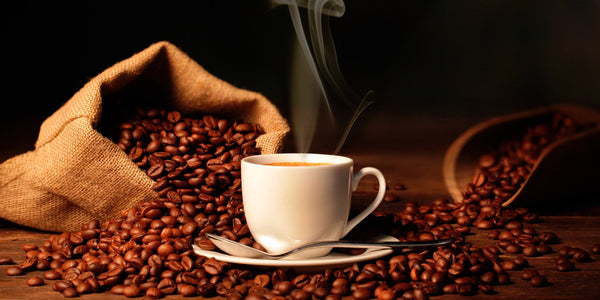Best Beans to Make An Espresso⎮What You Should Know
Jun 09, 2019
The single most asked question we get after a person has invested in an espresso machine is: “Which beans are the best beans to make an espresso?"
While this is a difficult question to respond to because “the best” really is contingent on so many variables, with the ultimate determinator being the individual palette, there is some basic information that will help you make an informed choice. Read on to know what to consider when choosing beans.
What you need to know
Understanding how to choose the best beans for espresso really requires developing an understanding of bean varieties and the how those beans are roasted. Understanding these two variables will provide the consumer with the base knowledge to begin to make informed choices Once the choice of beans is made, the next stage will be experimentation and tasting lots of cups of espresso to find the best beans to suit individual taste and preference.
What is for sure is that nothing influences the taste of espresso more than roasting process.
What is meant by "roast"
Coffee beans start off green. They are then placed in drums where they are cooked or to use coffee terms,“roasted”. Through this process, the bean changes colour from green to various shades of brown. The two variables that affect how the beans are roasted are temperature and time.
Beans can be roasted (given colour) quickly by using high temperature, or they can achieve that same colour by using a low temperature but leaving it to roast for a longer period of time. While the end result in colour may appear the same, the taste of that roast will vary. If you think of this in terms of cooking it is like frying something (you food will be ready quickly) or braising (a slow cooking process). In the end both are ready to eat but the way to get there was completely different.
It is for this reason that “coffee roasting” is considered an art. The skill, knowledge, and experience of the roaster are evident in the final coffee roast produced.
There are some espresso tastes that are clearly bad by anyone’s standard
Beans that are too light.
- In the roasting process the internal temperature of the bean never rises above 390℉/200℃.
- The colour remains a pale brown.
- The flavour oils remain undeveloped.
- These are not ideal at all for espresso, although some “new wave” roasters are presenting this as the “blonde” espresso.
- The coffee will taste grassy, sour, and will be without aroma.
Beans that are too dark.
- In the roasting process, the internal temperature of the bean spikes above 480℉/250℃ and the colour is definitely black.
- Most of the flavour oils will have been burnt out of the bean.
- The woody part of the bean will be charred and scorched.
- The coffee will be very think-bodied, burned, and charcoal tasting.
Other pitfalls to avoid when buying the best espresso beans
Buying Beans Identified by Brewing Style
A common pitfall when buying beans is buying beans identified as “espresso beans” on the label. A consumer may immediately think this is the ideal bean for their espresso maker only to find out those beans do not produce a coffee like they tasted while on vacation in Italy.
The first thing to know is there is no such thing as “espresso beans”. There are only coffee beans. Espresso is a method of brewing those beans. Other brewing method include drip, pour over, French press, Aeropress, and so on. The beans labelled espresso could be used in any of these brewing methods.

Buying Beans Identified with a County or Geographic Region
Don’t fall victim to the terms and language used on packaging to make your bean choice for espresso.
A common way to label of identify beans is by the nation most associated with a certain coffee brewing style. You may see Italian, French, etc. on the labels. There is the assumption that both of these roasts may be ideal coffee beans to use in your espresso machine. While both of these countries are certainly espresso drinkers, there is a wide range of preference.
In Italy, for example, the profile of an espresso in Naples is quite different than the espresso you will find in Northern Italy. The same holds true in France.
What to consider when choosing the perfect beans for an espresso
The big question then when choosing coffee beans is this: “Which roast will produce the best tasting coffee for the brewing method I will be using?"
This brings us back to understanding coffee roasts best suited for making espresso.
Given that language can be vague and misleading, the Specialty Coffee Association of America developed a method of classifying coffee roast based on reading of colour using a very precise instrument called an "Agtron", and assigning a number of each colour.
While colour roast numbers are not the common way of labeling coffee roasts at this time, there has been significant steps to use common roast names associated with a range of colour roasts. his move has certainly helped to reduce the ambiguity and assist the consumer in making more informed choice about the roast they prefer.

Here are four of the eight colour ranges commonly used to identify coffee roasts as developed by the SCAA.
It is up to the consumer to experiment with that roast in their preferred brewing style to find the match that works best for their coffee preferences.
So which roast is best for making an espresso? As previously mentioned, when making espresso, it is best to avoid roasts in the very light and very dark categories. Choosing beans that have been roasted in the light-medium to moderately dark range work best for the espresso brewing method.
Why choose beans in the light-medium to moderately dark range for espresso?
Beans roasted in this range will display the following characteristics that are those most commonly sought after in the iconic coffee known as espresso:
- The characteristics of the bean variety will still shine through in the coffee taste.
- The oils appear on the surface of the bean in tiny droplets, patches, or a slight shiny coating. This amount of oil adds to the overall taste, but also helps to develop the crema associated with a good espresso.
- The coffee will be full bodied and have a richness in mouthfeel.
- When you move to the darker side of the range, you will get the chocolate notes and a slight pleasant bitterness emerge which is associated with espresso.
The second big consideration in pursuit of the perfect espresso is which beans: Arabica or Robusta?
The coffee plant is an evergreen shrub which thrives up to an altitude of 2000 to 2500 metres in the tropical belt around the planet. The fruit is referred to as the "cherry", which contains two seeds. The seeds are oval in shape, with a centre cut down the middle and turn into coffee beans as they ripen.
Arabica and Canephora (better known as Robusta) are the main species used in the commercial production of coffee throughout the world.
The two species differ in the shape of the bean: the Arabic is flatter and longer, with a sinuous centre cut, while Robusta strains are convex and have a straighter centre cut. The caffeine amounts also different: an espresso made with a pure Arabica contains 40 to 65mg of caffeine, while Robusta has around double the amount 80 to 120mg of caffeine.
Arabica blends produce a coffee with a subtle aroma and a caramel aftertaste. Robusta, on the other hand, lends a certain body to an espresso, but its aroma is rather flat and tends to be woods which is not to everyone’s liking.
Coffee blends make for the best espresso
If we look to Italy as being the motherland of great espresso, they say that the "5 Ms" go into a great espresso:
- Mano (hand) of the barista. His skill and knowledge.
- Miscela: blend of the coffee beans.
- Machina: machine that is used to make the coffee.
- Mascinatore: the grind of the coffee.
- Manutenzione: maintenance of the equipment.
While single origin coffees are the big rage in North America, Italians maintain the best coffee can only be achieved by blending various types of coffees. They not only blends from various countries, because each has its own characteristic and profile, but they also blend varieties.
They do so because each variety, the Arabica and the Robusta, brings characteristics to the espresso that creates complexity which cannot be achieved with a single variety.
You will find the best cafés only use blends in to make their espresso. A combination of both Arabica and Robusta make up their signature blends.
When you add the variables of bean varieties, geographic origin, and conditions in which the beans have been grown and the methods in which they have been harvested, you can begin to imagine the nuances and range of taste that emerge in the final product.
This is why it is so difficult to answer the question: "Which beans are the best to make an espresso?"
Other pitfalls when choosing beans for the perfect espresso
- Don’t follow price: More expensive doesn’t mean better or tastier. Beans from islands like Jamaica or Hawaii are generally more expensive not because they taste better, but because the cost of production is much more and there are generally less beans available.
- Keep an eye on freshness: Look for a roast date on the bag. Coffee needs to rest after it is roasted between one and four days, and it reaches its peak flavour between five and ten days after roasting. You will find the top quality beans packaged in bags the contain air valves. These type of bags are specifically used to help freshly roasted coffee release gasses after the roasting process.
Taking care of your coffee beans
Finding the perfect beans for your espresso is really a process. It required research, time, and patience. So once you have found those beloved beans, be sure to take good care of them. Here what you need to do:
- Store the beans in a manner that protects them from air, heat, and moisture. It is not essential to buy special containers. Reseal bags and place in a dry cupboard away from sunlight.
- Do not put beans in the fridge or freezer, no matter what anyone says. The moisture that accumulates on the bean can cause issues for use in super automatic espresso machines. Additionally, the moisture build up impacts the taste. Additionally, beans will absorb smell from nearby foods.
It may seem it would be difficult to achieve a great tasting espresso at home. It is not. Do not get discouraged. To make good espresso at home, you need not be a professional roaster, but you should be an informed consumer. Finding the perfect espresso will take time and patience. Before you buy consider at minimum the following:
- Is this a blend of Arabica and Robusta?
- What type of roast am I getting?
The next step will be to make espresso in your machine: experiment with the grind and intensity (which are very simple to do on a superautomatic espresso machine) to see if the beans you chose produce an espresso the way you like it.
As you develop in your preferences, you may want to begin explore beans from various countries. This is another factor that influences coffee taste. At least for now, you have a starting point when looking for the best beans for making an espresso.






1 comment
Really a nice article, I have just ordered my espresso machine and, as you said, am now wondering “what beans should I buy”.
Fortunately we have a food store with bulk-beans of many types so I expect to apply the lessons you have taught and have a wonderful time experimenting!!